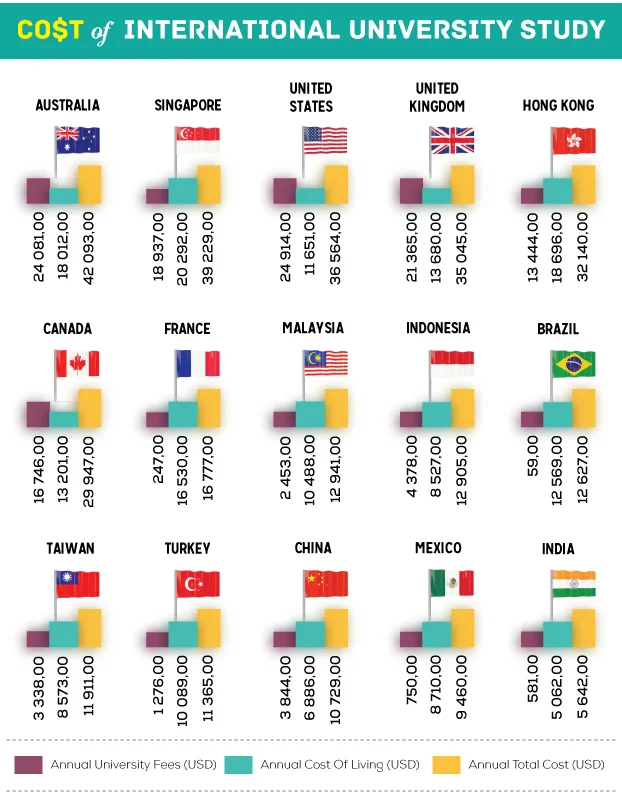Malaysia Is 3 Times Cheaper Than Australia For International Students
April 04, 2024
EasyUni Staff
In the infographic* below, we've broken down the costs for studying in the top 15 study abroad destinations for international students. Take a look at the costs (in USD) of international university study separated by tuition fees and cost of living to help you plan for your future education.

Another research report, The Value Of Education, from banking giant HSBC stated that Malaysians consider UK, Australia and Malaysia as their top 3 study destinations, in that order. This is despite the fact that studying in Australia is (on average) USD $29,152 more expensive annually than studying in Malaysia; studying in the UK is USD $22,104 more expensive than Malaysia. = The willingness to bear this cost may come from the fact that only 45% of Malaysian parents think that the quality of Malaysian education is comparable to or better than that in other countries. This, combined with the fact that 88% of those Malaysian parents would consider sending their children (alone) overseas in order to receive better education, paints a picture of a large outflow of students. = There are many reasons parents want to send their children overseas. Many strongly believe that studying abroad will provide their children with more reputable degrees which will boost their career prospects. Others feel that there are better opportunities available for those who study and then work abroad. The added advantage of becoming a more mature, worldly person also factors into parents' decisions about sending their children abroad.
The most popular study abroad plan is via a twinning program. Many Malaysian students tend to enrol in twinning programs which involve studying in Malaysia for part of the degree before going overseas. This helps cut costs for parents as the cost of living in Malaysia is almost 10 times lower than that in Australia and UK. Despite this significantly lower cost, 51% of Malaysian parents wish they had started to save for their child's education earlier.
Simon Williams, Group Head of Wealth Management, HSBC, said:
“The key reasons to send children overseas are the acquisition of foreign languages, international experience, and independence. But an international education brings an extra dimension of complexity to planning, particularly financial planning. The majority of overseas education is privately funded by parents, and while the concept of a college fund is well established in the US, it is still the exception elsewhere.”
* This information about the average annual costs was compiled from publicly available data in 15 countries and territories. The annual university fee for each country was calculated on the average annual cost of tuition for undergraduate international students at the 10 largest public universities in each country. The two exceptions are Mexico and Indonesia. The annual university fees for Mexico and Indonesia were calculated on the fees for the top 10 universities in terms of their QS university ranking. Annual fees for each university was either sourced from the individual institution’s data (via their university website), by phone via their admissions departments, or from other credible websites. The cost of living was calculated by taking the average cost of living in the cities where these universities are located. Cost of living data was sourced from the Expatistan.
Kickstart your education in Malaysia
We'll help you find and apply for your dream university
You might be interested in...
- Raising Awareness of the Threat of Microplastics Pollution on International Mother Earth Day
- Essential Tips for International Students Studying in Malaysia's Big and Suburban Cities
- Misconceptions About Studying in Malaysia: Insights for International Students
- The Role of Education in Promoting Health Equity: Lessons from World Health Day 2024
- Studying Abroad Tips: What Should You Do Before Coming to Malaysia?
- International Students' Guide to Success in Malaysian Research Programs
- Returning Home or Staying Put: Planning Your Career Path After Studying in Malaysia
- Crafting a Greener Tomorrow: Empowering Change through Zero Waste and Upcycling Practices
- Malaysian Higher Education's Global Outreach: Collaborations with International Institutions
- Initiatives by Universities in Malaysia to Prepare Students for Globalization








